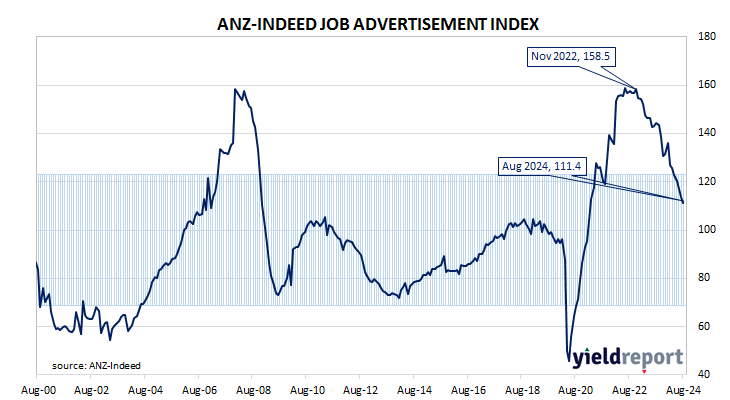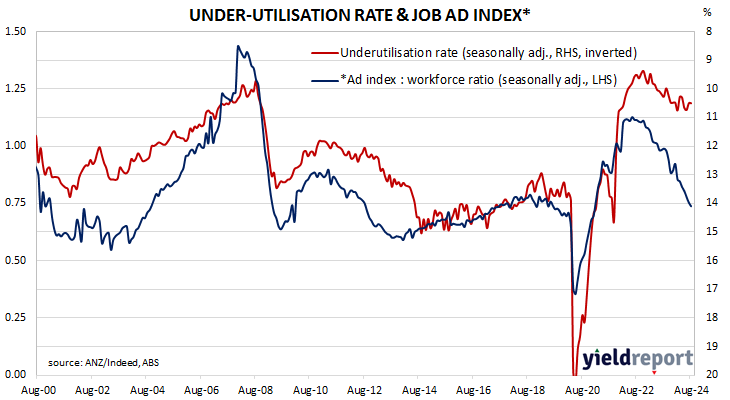Summary: Job ads down 2.1% in August; 22.9% lower than August 2023; ANZ: seventh consecutive monthly decline; ACGB yields rise; rate-cut expectations soften, February cut no longer fully priced in; ANZ: part of decline likely due to workers finding jobs; Westpac: still 11.4% above pre-pandemic levels; ad index-to-workforce ratio declines.
From mid-2017 onwards, year-on-year growth rates in the total number of Australian job advertisements consistently exceeded 10%. That was until mid-2018 when the annual growth rate fell back markedly. 2019 was notable for its reduced employment advertising and this trend continued into the first quarter of 2020. Advertising then plunged in April and May of 2020 as pandemic restrictions took effect but recovered quite quickly, reaching historically-high levels in 2022.
According to the latest reading of the ANZ-Indeed Job Ads Index, total job advertisements in August decreased by 2.1% on a seasonally adjusted basis. Their index fell from 113.8 in July after revisions to 111.4, with the loss following falls of 2.7% in July and June respectively. On a 12-month basis, total job advertisements were 22.9% lower than in August 2023, down from July’s revised figure of -20.5%.
“ANZ-Indeed Australian Job Ads declined in August for the seventh consecutive month to be down 15.3% so far in 2024,” said ANZ economist Madeline Dunk.”
Commonwealth Government bond yields rose across the curve on the day, somewhat outpacing the upward movements of US Treasury yields on Friday night. By the close of business, the 3-year ACGB yield had gained 6bps to 3.60%, the 10-year yield had added 4bps to 4.02% while the 20-year yield finished 6bps higher at 4.42%.
Expectations regarding rate cuts in the next twelve months softened, with a February 2025 rate cut now longer fully priced in. Cash futures contracts implied an average of 4.33% in September, 4.32% in October and 4.28% in November. February 2025 contracts implied 4.115% while August 2025 contracts implied 3.55%, 79bps less than the current cash rate.
“Yet employment has risen by 318,000 in 2024…and six-month average employment growth is running at its strongest pace since late 2022,” Dunk added. “Part of the decline in the series, which measures total job ads rather than new job ads, is likely due to workers finding jobs.”
Westpac senior economist Pat Bustamante noted job advertisements may have fallen but only from a high base. “Job ads have fallen 29.8% from their peak in November 2022 but are still 11.4% above pre-pandemic levels.”
The inverse relationship between job advertisements and the unemployment rate or the underemployment rate has been quite strong (see below chart), although ANZ themselves called the relationship between the series into question in early 2019.
A higher job advertisement index as a proportion of the labour force is suggestive of lower unemployment rates in the near future while a lower ratio suggests higher unemployment rates will follow. August’s ad index-to-workforce ratio declined from 0.75 after revisions to 0.74.
In 2008/2009, advertisements plummeted and Australia’s unemployment rate jumped from 4% to nearly 6% over a period of 15 months. When a more dramatic fall in advertisements took place in April 2020, the unemployment rate responded much more quickly.



